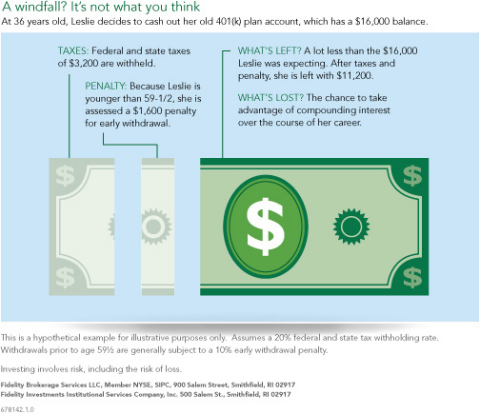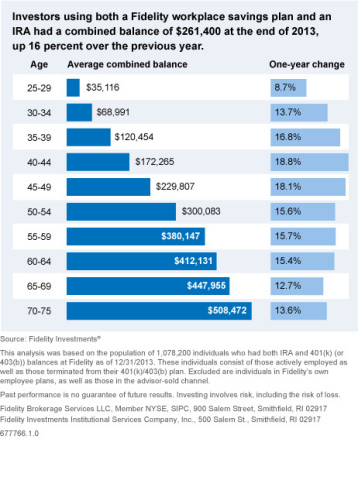BOSTON--(BUSINESS WIRE)--Fidelity Investments® − the nation’s largest 401(k) provider1 − today announced the average 401(k) balance continued its growth trend to end the fourth quarter of 2013 at a new record high of $89,300, up 15.5 percent from one year earlier, and nearly double what is traditionally considered the market low of March 2009 when it was $46,2002. For pre-retirees age 55 and older, the average balance is $165,200. While 78 percent of the year-over-year increase was due to positive stock market momentum, a full 22 percent of the growth came from employee and employer contributions, such as company matches, demonstrating the importance of continued participation and contributions, no matter the market conditions.
To provide a more complete picture of retirement savings, Fidelity also studied the combined balance for investors who hold both a 401(k) and Individual Retirement Account (IRA) with the firm3. For these investors, the combined 401(k)/IRA average balance is $261,400, up 16 percent from the end of the fourth quarter 2012 when it was $225,600 (see chart).
However, Fidelity’s analysis also revealed a concerning statistic: more than one third (35 percent) of all participants cashed out their 401(k) balances when leaving their job in 20134. The trend is highest for younger participants ages 20 to 39 – those with the greatest opportunity to build long-term wealth due to their extended savings horizon – as 4 in 10 (41 percent) cashed out. With the average cash out value at nearly $16,000, many 401(k) investors are forfeiting years of potential investment growth and retirement cash flow.
“People with a 401(k) who change jobs have a critical decision to make: take the quick cash, or keep the balance in their existing plan or roll it over into another tax-advantaged account, two options that may provide them considerable income in retirement,” said James MacDonald, president of Workplace Investing at Fidelity. “Fidelity knows this decision isn’t easy. Everyone’s personal financial situation is different and there are times when a person must have access to cash. However, we urge all investors – especially young savers with years of potential investment gains – to keep their 401(k) savings working for them in a tax-advantaged retirement account when changing jobs.”
The consequences of cashing out a 401(k) may be significant. For example, a hypothetical 30-year-old who cashes out $16,000 could lose $471 per month in retirement income cash flow by not leaving it invested in a retirement account (assuming he or she retires at 67 and lives through 93)5. People also pay applicable federal and state taxes plus a 10 percent penalty for early withdrawal. In this hypothetical example, a $16,000 cash out would result in about $3,200 in taxes6 and another $1,600 in penalties, leaving about $11,200 (see graphic).
There are alternatives to cashing out a 401(k) that provide investors investment flexibility. They include keeping the balance in a former employer’s plan7, rolling-in balances to a new employer’s plan if eligible, or rolling-over balances into an IRA. In doing so, investors preserve their opportunity to build long-term positive outcomes by keeping their assets in a tax-advantaged retirement savings account.
“Cashing out is tempting, especially in times of transition like changing jobs,” said MacDonald. “That’s why we work closely with thousands of employers to help educate employees on both the cost of cashing out as well as the tremendous opportunity for growth by remaining invested.”
Educational Guidance Helping Millions of Retirement Investors
Fidelity offers educational help to all investors. As part of its workplace participant experience, Plan for Life, participants have access to educational help at every stage of their career. In 2013, Fidelity conducted nearly 4 million workplace guidance sessions, a 57 percent increase over 2012, and delivered more than 200 million communications across numerous channels – electronic, print, smartphone app, podcast and video. In addition, usage of Web tools more than doubled last year.
The company provides guidance through easy-to-understand online tools, from telephone representatives, over smartphones and tablets, in workshops, and at our more than 180 investor centers nationwide. It also posts educational content to its NetBenefits® Library for workplace plan participants, as well as Viewpoints on Fidelity.com about market insights, investing ideas, trading and personal finance, including a new article on the impact of cashing out a 401(k).
Media-Ready Infographics Available
Fidelity has media-ready infographics depicting the taxes and penalties associated with cashing out a 401(k) (see image) and the average combined 401(k)/IRA balance by age (see image).
About Fidelity Investments
Fidelity Investments is one of the world’s largest providers of financial services, with assets under administration of $4.6 trillion, including managed assets of $1.9 trillion, as of December 31, 2013. Founded in 1946, the firm is a leading provider of investment management, retirement planning, portfolio guidance, brokerage, benefits outsourcing and many other financial products and services to more than 20 million individuals and institutions, as well as through 5,000 financial intermediary firms. For more information about Fidelity Investments, visit www.fidelity.com.
Keep in mind that investing involves risk. The value of your investment will fluctuate over time and you may gain or lose money.
Diversification does not ensure a profit or protect against a loss.
Past performance is no guarantee of future results.
Fidelity Brokerage Services LLC, Member NYSE, SIPC
900
Salem Street, Smithfield, RI 02917
Fidelity Investments Institutional Services Company, Inc.
500
Salem St., Smithfield, RI 02917
678805.1.0
© 2014 FMR LLC. All rights reserved.
1 This statement is based on the results of a combination of independent media surveys. Fidelity was ranked first in DC assets under administration as of December 31, 2012 by Pensions & Investments’ annual Defined Contribution Record Keepers Survey, first in total recordkeeping assets and participants as of December 31, 2012 by PLANSPONSOR in its annual Defined Contribution Recordkeepers Survey, and first in DC assets recordkept as of December 31, 2012 in Cerulli Associates Quantitative Update Retirement Markets 2013.
2 All data in this announcement are as of December 31, 2013 unless otherwise stated and are based on more than 21,000 corporate defined contribution plans and 12.5 million participants.
3 The combined population of investors who hold both 401(k) (or 403(b)) and IRA balances at Fidelity is 1,078,227. These individuals consist of those actively employed as well as those terminated from their 401(k)/403(b) plan sponsor. Only a subset of these individuals made contributions into their IRAs and/or 401(k)/403(b) plans in 2013. Excluded are individuals in Fidelity’s own employee plans, as well as those in the advisor-sold channel. Additionally, many workplace plan participants presumably have IRAs that are not serviced by Fidelity, and these balances are not reflected.
4 Participant left employer between January 1 and September 30, 2013.
5 This hypothetical example assumes an annual real return of 4.7% and systematic withdrawal payments from retirement age 67 through death age 93. All values are expressed in today’s dollars (i.e. inflation is not included). Balance at retirement age 67 would have been $87,500. The ending values do not reflect taxes or fees; if they did, amounts would be lower. Earnings and pre-tax contributions are subject to taxes when withdrawn. This example is for illustrative purposes only and does not represent the performance of any security. Individuals may earn more or less than this example. Investing on a regular basis does not ensure a profit or guarantee against a loss in a declining market.
6 Each individual’s tax implications are dependent on their personal tax rate and state or residence. This hypothetical scenario assumes a 20% withheld tax rate.
7 Available to investor only if plan rules permit this option.





